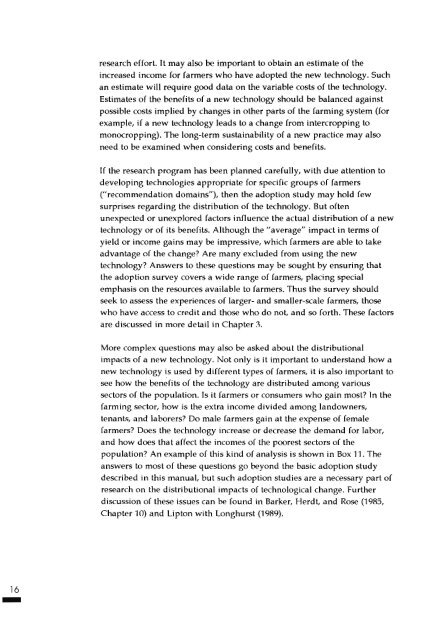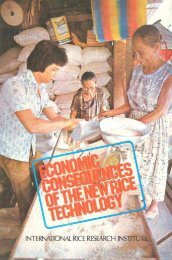The Adoption of Agricultural Technology - Food Security Group
The Adoption of Agricultural Technology - Food Security Group
The Adoption of Agricultural Technology - Food Security Group
You also want an ePaper? Increase the reach of your titles
YUMPU automatically turns print PDFs into web optimized ePapers that Google loves.
esearch effort. It may also be important to obtain an estimate <strong>of</strong> theincreased income for farmers who have adopted the new technology. Suchan estimate will require good data on the variable costs <strong>of</strong> the technology.Estimates <strong>of</strong> the benefits <strong>of</strong> a new technology should be balanced againstpOSSible costs implied by changes in other parts <strong>of</strong> the farming system (forexample, if a new technology leads to a change from intercropping tomonocropping). <strong>The</strong> long-term sustainability <strong>of</strong> a new practice may alsoneed to be examined when considering costs and benefits.If the research program has been planned carefully, with due attention todeveloping technologies appropriate for specific groups <strong>of</strong> farmers("recommendation domains"), then the adoption study may hold fewsurprises regarding the distribution <strong>of</strong> the technology. But <strong>of</strong>tenunexpected or unexplored factors influence the actual distribution <strong>of</strong> a newtechnology or <strong>of</strong> its benefits. Although the "average" impact in terms <strong>of</strong>yield or income gains may be impressive, which farmers are able to takeadvantage <strong>of</strong> the change? Are many excluded from using the newtechnology? Answers to these questions may be sought by ensuring thatthe adoption survey covers a wide range <strong>of</strong> farmers, placing specialemphasis on the resources available to farmers. Thus the survey shouldseek to assess the experiences <strong>of</strong> larger- and smaller-scale farmers, thosewho have access to credit and those who do not, and so forth. <strong>The</strong>se factorsare discussed in more detail in Chapter 3.More complex questions may also be asked about the distributionalimpacts <strong>of</strong> a new technology. Not only is it important to understand how anew technology is used by different types <strong>of</strong> farmers, it is also important tosee how the benefits <strong>of</strong> the technology are distributed among varioussectors <strong>of</strong> the population. Is it farmers or consumers who gain most? Tn thefarming sector, how is the extra income divided among landowners,tenants, and laborers? Do male farmers gain at the expense <strong>of</strong> femalefarmers? Does the technology increase or decrease the demand for labor,and how does that affect the incomes <strong>of</strong> the poorest sectors <strong>of</strong> thepopulation? An example <strong>of</strong> this kind <strong>of</strong> analysis is shown in Box 11. <strong>The</strong>answers to most <strong>of</strong> these questions go beyond the basic adoption studydescribed in this manual, but such adoption studies are a necessary part <strong>of</strong>research on the distributional impacts <strong>of</strong> technological change. Furtherdiscussion <strong>of</strong> these issues can be found in Barker, Herdt, and Rose (1985,Chapter 10) and Lipton with Longhurst (1989).-16



